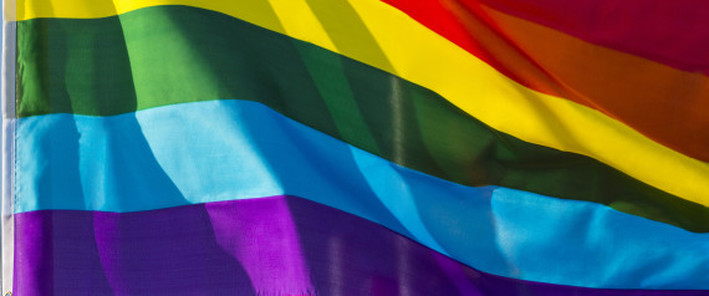
Although I identify as gay, for the purpose of this post I'll use the word queer because it is more encompassing of the whole non-heterosexual community. Likewise, I will use the word justice rather than equality. Equality means having the same things, be they privileges, rights, expectations or values. For many marginalized groups such as queer people and stutterers, we want space but it doesn’t look exactly the same as the space occupied by heterosexuals and fluent people. We are different and may need accommodations, special privileges, or even advantages. Many of us enjoy the difference and don’t want to be typical. We enjoy being unconventional, and for some, even a bit subversive.
Growing up queer or as a stutterer can be extremely isolating. Due to the relative rarity of both traits, one may find themselves without someone in their family or community to identify with. Both can make a person an easy target for bullies. Being a stutterer can isolate a queer person even further. Before I met my partner, I found it difficult to initiate the small talk required to engage with the few gay men I encountered. I didn’t use dating apps because I felt I should disclose my stuttering and would probably not even be given a chance for a first date.
But why? What makes these variations so stigmatizing or distasteful? Until quite recently, homosexual acts have been considered crimes against nature. Many religions ban homosexuality. The texts of Islam, Judaism, and Christianity all seem to have passages that expressly forbid it. Long ago, secular laws were created to punish people who committed these acts. While stuttering may not be forbidden, in some religions or denominations, it might be considered a sign of demonic possession or a symptom of lack of faith. In the best case scenario, a stutterer becomes an object of pity and prayer. In both instances the individual may feel tested or even abandoned by their God. This may be the origin of shame for many of these individuals.
The etiology and treatment for both homosexuality and stuttering has followed similarly twisted paths. Both have been treated as medical and mental health issues. Historically, therapies have focused on “curing” or “normalizing.” It wasn't until 1973 that homosexuality was removed from the Diagnostic and Statistical Manual of Mental Disorders. In contrast, while the most recent DSM-5 has changed the wording from 'stuttering' to 'Childhood-Onset Fluency Disorder', it is still included as a pathological condition.
On a recent episode of the podcast StutterTalk, guest Christopher Constantino suggested that speech therapy take a page from homosexual reparative therapy by changing the focus from normalization to helping individuals deal with the stresses imposed by society. “I think it’s fairly analogous to the way the field of psychology used to treat gay individuals who were struggling with their sexuality. They used to try to give them therapy so that they would become straight individuals and over time that has thankfully changed.”
This has been my experience exactly. I've had therapy to help deal with the way my parents reacted when I came out, but the therapist never insinuated that things would be easier if I was less gay. On the other hand, the speech therapy I've had as an adult focused very strongly on how things would be easier for me if I was more fluent. I bought it for a while and worked hard to manage my stuttering. It took me about two years to realize that what made me slightly more fluent was in fact sabotaging my communication. Soon after, I quit speech therapy and haven't returned since. Frankly, the message I've taken from the stuttering pride community has eliminated any need.
Another thing I've encountered after becoming involved with stuttering pride is the critical reflection on person first language. The queer community doesn't do person first. I am a gay man. That's it. We fully embrace this identity and don't need reminders that we are people first. While working on this post, I got an email from a friend who is both a minister and a lesbian. She shared that she was recently told by a colleague that, in his mind, she was “firstly a Christian” and that the label ‘gay’ didn't change anything about her. Needless to say this bothered her because identifying as a lesbian is very important to her and has provided considerable social bonds to other people within her church community.
This brings me to another lesson the fight for dysfluent justice can learn from queer justice: Community. A community of like-minded people is so important for both groups. It helps to build identity and a place to share similar experiences. I have learned so much from the community of stutterers I've met both in person and on the web. I have even been fortunate, with the help of social media, to find others who fit in both subsets like me. In grad school I attended a queer student group (where I met my partner) and recently I have attended meetings of a local stuttering group. Queer groups may have straight ally members, but not people who are trained to change them.
One final, but very key place queer justice has really taken off is in the media. TV, movies, and radio overflow with queer characters, hosts, and actors. Similarly, it has become much more common for queer actors to play queer characters. These are directions the media needs to move with all disabilities. This has been a fairly recent development and has most likely contributed to more acceptance and the breakdown of misconceptions. Stutterers need to demand more realistic and positive representation in the media. Stereotypes and negative portrayals are much more common than realistic and positive portrayals. For example, on a recent episode of Orange is the New Black, a character prefers to be mute than to reveal she stutters.
Queer activism began with acknowledging differences and sometimes being at odds with dominant culture. While queer activism demanded (and still demands) many of the same rights and privileges of that culture, it does not want assimilation. It means causing a bit of discomfort in the dominant culture. This is exactly what I see going on here at DIS. To stutter is to be different and to be proud of that difference. It means demanding accommodations, representation, and the ability to choose not to change. It means forming communities and spreading this message. It means coming out of our stuttering closets and making ourselves visible. We are at the beginning of this process, and we have a long way to go, but I think it is possible.
-Eli






 RSS Feed
RSS Feed
